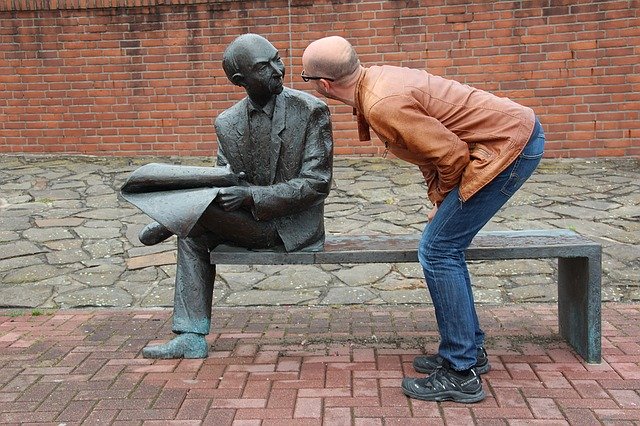Dynamic Dialogue

I teach writing classes, and one of the things I see most often is awkward, stilted or boring dialogue. Why? Because dialogue in writing is not like dialogue in real life. It’s real life on steroids. It’s all the great stuff without all the, how-are-you’ s, um’s and awkwardness. It’s all the stuff you lie in bed thinking you should have said.
What is good dialogue? For an example, my go-to is always Darynda Jones. This is from First Grave on the Right:
‘You set one foot in this bathroom, and I will melt your face with my transcendental pest repellent.’
His eyes widened. ‘Seriously?’
‘No,’ I said, shoulders deflating. I had a really hard time lying to the departed. ‘It’s just water. But don’t tell Mr. Habersham, the dead guy in 2B. This bottle is the only thing that keeps that dirty old man out of my bathroom.’
Aside from her sparkling humor, this is so well written. Not a spare word, awkward phrase or um in sight. Your dialogue should flow like water through a sluice, fast and smooth.
But how do you do that?
Here’s some tips:
- Dialogue is never a way to tell the reader what the characters know. We call this a, ‘You know, Bob’. Think about it. How often, when talking with your sister, do you say, ‘Well, as you know Suzie, mom and dad married in 1978.’ This is a sure sign of a newbie. It’s not real- it’s the author trying to tell the reader what you think they need to know. And 100% of the time, they don’t. Find a way to slip important information in another way.
- Avoid using the other person’s name. If you’re talking to your friend, or even a person you just met, you don’t use their name. Try it. Have a conversation (we’ll wait). Bet you money you didn’t say, ‘Well Gary, …’. So don’t use it in your writing. It’s just not realistic, and real is everything in written dialogue.
- Tell us only what we don’t know. There is nothing more mind-numbing to a reader is dialogue that tells what we already know. Okay, say the scene before was that a friend fell down the stairs at school, in a skirt, not wearing underwear (hey, don’t judge). If someone who was there is telling a person who didn’t witness it about it, do not use even the shortest description of the scene. It invites skimming. All it takes is,
‘You’re not going to believe what just happened.’
Pookie raises a skeptical eyebrow. ‘What?’
I relate Saundra’s epic fall and parting shot.
- Cut every extra word Seriously. Every. Extra. Word. (see how I just repeated? Irritating, isn’t it?) No, ‘Hi Nikki, how are you?’ Yes, I know we do this in real life. This isn’t. Dive right into the meat of it. Also, your reader trusts that if you said it, you meant it. No repeats.
‘Bruce?’ He slept on. “Bruce, are you all right? Bruce?” I touched his arm.’
Not only does this repeat, it uses his name! It becomes:
‘Hey.’ I shook his arm. ‘Are you alive?’

- Dialogue tags. I hate them. Yes, I know, people say they’re transparent. They aren’t to me – they’re Chinese Water Torture, drip, drip, dripping until I want to throw the book at the wall. The ONLY time you need a tag, is when the reader wouldn’t know whom is speaking. Rapid-fire back and forth? If we know who started it, trust your reader to figure out who says what. Two of different sexes? Use the pronoun. Besides, you can do better than a tag. Use what Margie Lawson calls, Dialogue cues, to show us something about how it’s said, instead.
‘And guess who’s going to be picking up slack while you’re out playing?’ She asked.
Becomes:
‘And guess who’s going to be picking up slack while you’re out playing?’ Hand on hip, she gave him the wrong-answer-only glare.
Seriously. do a ‘find’ in your book for, ‘said’ or ‘asked’. With only a bit of brainpower, you can do so much better. Little things like this make your POV closer, and your text meatier.
- Paragraph breaks. This is something I see all the time, too. Watch the breaks in the following:
‘So, what do you want me to say?’
From the look on his face, the truth wasn’t coming out of his mouth anytime soon.
His foot tapped. ‘Seriously. I want to know.’
‘Lie to me?‘
Man’s dialogue line/her thought/his line/her line. See how, though it’s not all dialogue, it’s still broken by who’s thinking/speaking? If the POV character speaks, has a thought, speaks again – one paragraph.
- Last tip: read it out loud. Nothing will highlight a clunky, awkward or slow line more than reading it out loud. What looks good on the page doesn’t always sound as good, out loud. Trust me, I know. They’ve made audiobooks of my novels, and sometimes, I cringe.

Dialogue, done right, can be the best part of your book. Take time to make it sparkle!
Have any questions for me?
Will you share a bit of your good dialogue in the comments?
[…] wonderful characters have to talk, so Laura Drake concnetrates on dynamic dialogue, and James Scott Bell urges writers to have your characters say what you wish you’d […]